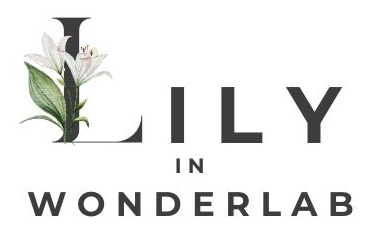This delightful DIY lip balm, rich in nourishing and reparative oils and butters, contains an interesting and new DIY Cosmetics ingredient, liposoluble hyaluronic acid, and the fragrant rose wax. For this reason, I decided to call it "Hyalu-Roses".
The application of this lip balm is a smooth and easy experience, made possible also by the addition of phytosterols, which not only regenerate the lips but also improve the comfort and the texture of the cosmetic.
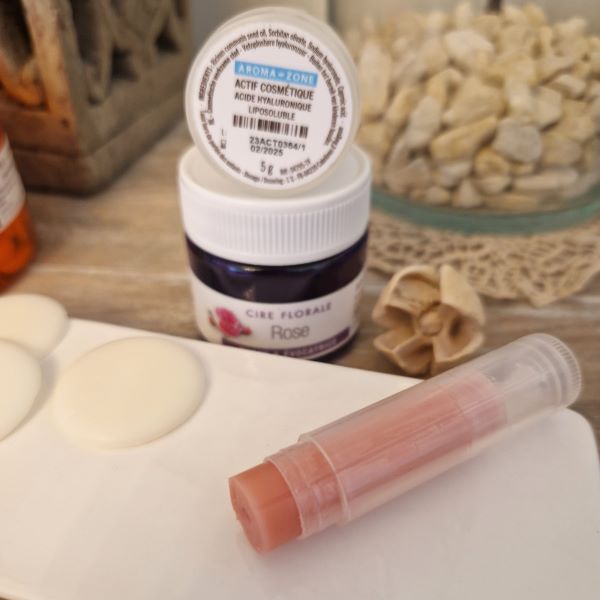
Liposoluble hyaluronic acid, a major innovation available in some DIY Cosmetic ingredients stores (mine is from Aroma-Zone), is known for its plumping, smoothing, and volumizing properties on the lips. Normally, hyaluronic acid is water-soluble, but thanks to its esterification with caproic acid, it becomes lipophilic and can be incorporated into anhydrous oil-based cosmetics. This extraordinary innovation allows us to make our lip balms even more moisturizing and effective. To incorporate it into the recipe, it is necessary to slightly warm the oil phase.
When formulating a product for the lips, which are characterized by a semi-mucous membrane subject to redness and chapping caused by the external environment, it is advisable to choose oils and butters that are particularly soothing, regenerating, and anti-inflammatory.
Castor oil is the best choice you can make for your DIY lip balms. It contains ricinoleic acid, which is anti-inflammatory and enhances hydration because it is absorbed slowly, protecting the lips for a long time retaining water.
Cocoa butter is a classic for dry and chapped lips, while mango butter restores the lipid barrier and is anti-inflammatory.
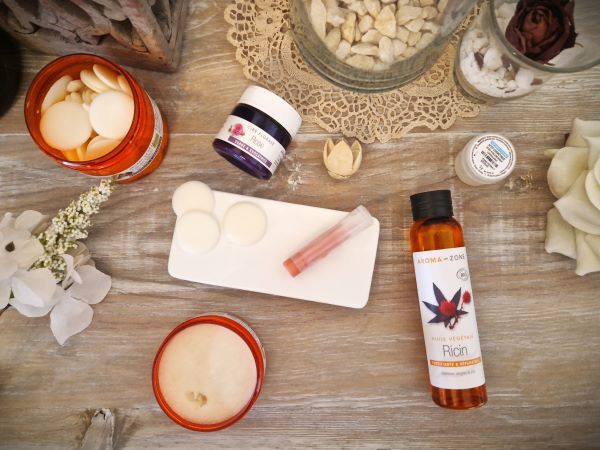
Waxes, in addition to giving consistency to the stick, have a protective effect and create an occlusive film that retains moisture, ensuring greater product durability.
If you try to spread butter or oil directly on the skin, you will notice that the emollient and moisturizing effect disappears within a few minutes. Waxes, on the other hand, ensure that oils and butters remain longer on our lips.
In this case, I chose beeswax, which has a creamy and pleasant texture, and to avoid interference with the scent of rose wax, I opted for white beeswax, which is usually odorless.
It has a medium film-forming power, unlike waxes like candelilla wax, which have a high film-forming power, a greater hold and a less sticky effect, but could be a bit too hard. In this formula, I wanted to obtain a DIY lip balm stick with a soft and creamy consistency to the touch.
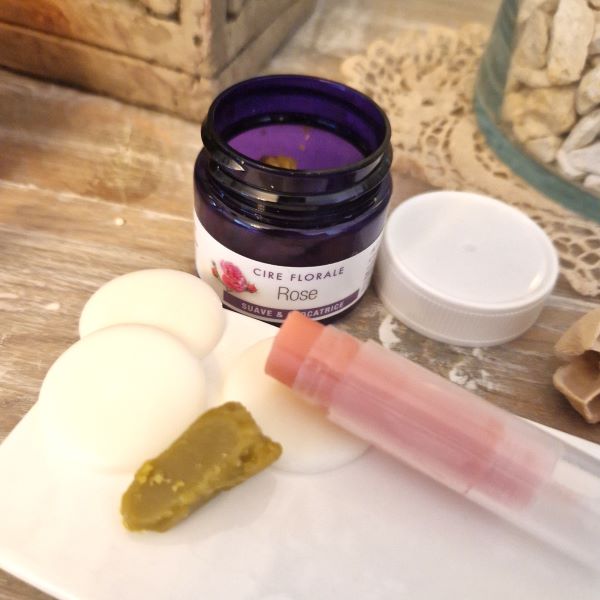
Rose wax, which is not actually a wax but is derived from the extraction of the absolute, is used mainly for its scent in this case. Delicate and floral, it gives a wonderful scent and a very delicate flavor. It has a yellow-greenish color. For this reason, I opted for two drops of liposoluble Rouge Grenadine lip safe dye, obtaining a beautiful soft pink that does not color the lips but is a joy for our eyes! Something that sparkles joy…
This DIY lip balm is a treat for the lips. Try my "Hyalu-Roses" recipe and let yourself be conquered by its delicacy and effectiveness!
Recipe for Rose Wax DIY Lip Balm with Hyaluronic Acid and Phytosterols
Ingredients
- Cocoa butter: 38 %
- Castor oil: 21,5 %
- White beeswax: 22 %
- Rose wax: 4 %
- Mango butter: 8 %
- Phytosterol concentrate: 5 %
- Liposoluble hyaluronic acid: 1 %
- Vitamin E (tocopherol): 0,5 %
- Rouge Grenadine liposoluble dye: as needed (few drops till you reach the desired color)
All recipe ingredients are available from Aroma-Zone.
This recipe is presented in percentages (%). If you prefer to work with grams (g), you can easily convert the percentages to grams by using the same proportions. For example, if you wish to make 100g of the product, simply use the same percentages and convert them to grams accordingly (example: 38 g of Cocoa butter).
How to make the DIY Hyalu-Roses lip balm:
- Put cocoa butter, castor oil, beeswax, and rose wax in a beaker and melt them in a water bath.
- Liposoluble hyaluronic acid from Aroma-Zone should be incorporated into your formulation when the oil phase reaches temperatures between 75-80°C. Add it at this point and mix for at least 2 minutes. If you use a liposoluble hyaluronic acid from a different supplier, be sure to review the product specifications and guidelines for recommended usage instructions, as dosages and temperature requirements may vary.
- Add the rest of the ingredients: mango butter, phytosterol concentrate, vitamin E, and liposoluble lip safe dye. Mix well. Remove from heat as soon as they are completely melted.
- Pour into empty DIY lip balm tubes and let set for at least half a day at room temperature.
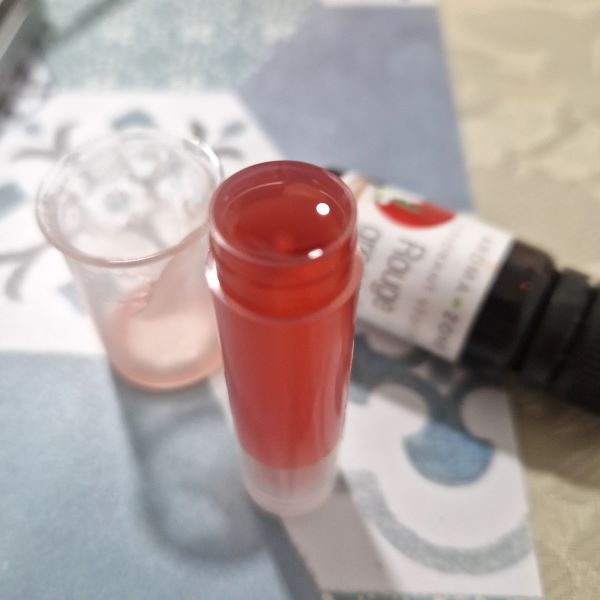
Notes and substitutions:
- Oils and butters can be replaced with others that are similar in properties and hardness. Check the oils and butters chart for more info.
- If you don't have rose wax, increase the amount of beeswax. In any case, to avoid hardening the lip balm too much, you can try replacing it with cocoa butter or with half cocoa butter (or mango butter) and half beeswax. Do not use orange blossom wax as it is bitter and therefore not suitable for the lips. Believe me… I tried it!
- If you don't have phytosterol concentrate or liposoluble hyaluronic acid, increase the amount of mango butter. They do not have the same properties but similar consistencies, and such a substitution avoids an imbalance in the final consistency.
- As mentioned before, liposoluble hyaluronic acid from Aroma-Zone should be incorporated into your formulation when the oil phase reaches temperatures between 75-80°C. Ensure thorough mixing for a minimum of 2 minutes to achieve optimal dispersion. However, if you opt for a hyaluronic acid variant from a different supplier, be sure to review the product specifications and guidelines for recommended usage instructions, as dosages and temperature requirements may vary. Always consult the product sheet for accurate information before incorporating it into your formulation.
- The lipsafe liposoluble dye is not necessary. You can omit it or replace it with a pinch of pink mica. Do not use water-soluble dyes since this is an oil-based recipe.
- If you omit rose wax and still want to give aroma to your lip balm, opt for a fragrance or aroma that is both liposoluble and lip safe. Even peppermint or sweet orange essential oils can be a good choice. Don't put more than the 0.1-0.5% of lip safe essential oils.
Find the italian version of this recipe in my Italian DIY cosmetics blog, Edenstylemagazine.it.

